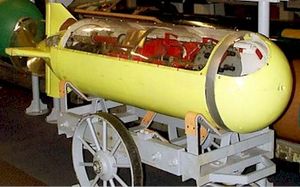Mark 24 FIDO Torpedo
| Mark 24 mine | |
|---|---|

Mark 24 acoustic torpedo
|
|
| Type | Acoustic torpedo |
| Place of origin | United States Canada United Kingdom |
| Service history | |
| In service | 1942–1948 |
| Used by |
United States Navy Royal Navy Fleet Air Arm Royal Canadian Navy |
| Wars | World War II |
| Production history | |
| Designer |
Western Electric Company Bell Telephone Laboratories Harvard University Underwater Sound Laboratory |
| Designed | 1942 |
| Manufacturer |
General Electric Company Western Electric Company |
| No. built | 4000 |
| Specifications | |
| Weight | 680 pounds |
| Length | 84 inches |
| Diameter | 19 inches |
|
|
|
| Effective firing range | 4000 yards (10 minutes search duration) |
| Warhead | HBX |
| Warhead weight | 92 pounds |
|
Detonation
mechanism |
Mk 142 fuze, contact exploder |
|
|
|
| Engine | Electric, secondary battery |
| Speed | 12 knots |
|
Guidance
system |
preset circle search, passive acoustic |
|
Launch
platform |
Aircraft |
The Mark 24 mine (also known as FIDO or Fido) was a US air-dropped passive acoustic homing anti-submarine torpedo used during the Second World War against German and Japanese submarines. It entered service in March 1943 and continued in service with the US Navy until 1948. Approximately 4,000 torpedoes were produced, sinking 37 and damaging a further 18 submarines out of a total of 204 fired. The torpedo was also supplied to the British and Canadian forces. The deceptive name of "Mark 24 Mine" was deliberately chosen for security purposes, to conceal the true nature of the weapon.
The US Navy began studies into an air-dropped anti-submarine torpedo in the autumn of 1941. Based on a formal set of requirements, Harvard Underwater Sound Lab (HUSL) and Bell Telephone Labs began development in December 1941. These later projects later became Office of Scientific Research and Development project 61 (FIDO).
Both Bell Labs and HUSL proceeded with parallel development of torpedoes, with a complete exchange of information between them. Western Electric were to develop a lightweight, shock resistant, 48 volt lead-acid battery capable of providing 110 amps for 15 minutes. General Electric were to design and fabricate propulsion and steering motors and to investigate an active acoustic homing system. David Taylor Model Basin was to assist with hydrodynamics and propulsion.
The guidance system consisted of four hydrophones placed around the midsection of the torpedo, connected to a vacuum tube-based sound processing array. A Bell Labs proportional and HUSL non-proportional steering system had been demonstrated by July 1942.
An existing Mark 13 torpedo provided the body of the torpedo, it was modified by shortening the hull, reducing the diameter, reducing the weight, and designing a hemispherical nose section to carry the explosive charge, and a conical tail section with four stabilizing fins and rudders and a single propeller. The effect of these modifications was to produce a relatively short, "fat" torpedo.
...
Wikipedia
